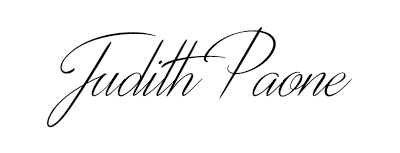

L’esplorazione del senso più profondo delle cose, l’enigma esistenziale costituito dagli oggetti e dai luoghi appartenenti al quotidiano e la necessità umana di mettere ordine ogni qualvolta lo sguardo viene ingannato e condotto verso situazioni apparentemente simili a quelle conosciute ma in realtà completamente differenti e decontestualizzate, hanno costituito la base di partenza per l’espressività di un nutrito gruppo di artisti del secolo scorso, ma anche della protagonista di oggi che fa dell’irreale il suo personale modo per narrare emozioni e sensazioni riconducibili a sé ma anche all’uomo contemporaneo.
Quando agli inizi del Novecento cominciò a delinearsi la tendenza espressiva di andare oltre il visibile ed esplorare non più l’emozione come già avvenuto nell’Espressionismo, bensì il mondo sotterraneo dell’inconscio, dei sogni ma spesso degli incubi di cui lo psichiatra austriaco Sigmund Freud portò alla luce la rilevanza nella vita quotidiana, alcuni artisti decisero di creare una corrente in cui la rappresentazione della sfera psichica, inquieta e irreale, fosse al centro della ricerca stilistica. Il Surrealismo, questo il nome del movimento di cui Salvador Dalì fu fondatore nonché uno dei principali rappresentanti, accolse al suo interno differenti modi di narrare l’inconscio umano, a volte più spostati verso gli incubi di un mondo in metamorfosi nel quale strane forme avvolgono parzialmente corpi e oggetti come nella produzione pittorica di Max Ernst, altri esponenti si focalizzarono sulle pulsioni più istintive e terrene, come quella sessuale o decisamente angosciante di universi paralleli popolati da animali inquietanti e oggetti deformati delle celeberrime opere di Dalì, o ancora vi fu chi volle mettere in evidenza il mistero del pensiero umano, il senso dell’esistenza e l’enigma che a volte si nasconde dietro un’apparenza perfettamente ordinata come nelle tele affascinanti e magnetiche di René Magritte. E ancora il mondo post-apocalittico costituito da scenari improbabili quanto sinistri di Yves Tanguy, la cruda interiorità, l’ossessione di sé e del proprio dolore fisico e interiore di una delle donne rappresentanti della corrente, Frida Khalo fino a giungere alla rappresentazione fanciullesca e ridotta all’essenziale e alle tonalità accese dell’outsider Joan Mirò. Nella contemporaneità il Surrealismo non smette di affascinare artisti che stanno lasciando una profonda traccia nella storia dell’arte attuale riattualizzando le linee guida del movimento e adattandole al proprio sentire tanto quanto alle incertezze interiori o a un mondo grazie al quale evadere dalla realtà quotidiana, come nel caso di Vladimir Kush, giovane e talentuoso artista di origini russe ma naturalizzato statunitense, le cui tele metamorfosiche e al tempo stesso poetiche non possono fare a meno di coinvolgere l’osservatore. L’altoatesina Judith Paone è tra le artiste donne emergenti che hanno scelto proprio il Surrealismo per manifestare la propria delicata interiorità; nelle sue opere lascia emergere emozioni che in virtù del silenzio suggestivo si amplificano, focalizzando l’attenzione e lo sguardo non solo sul dettaglio principale bensì su tutta l’atmosfera circostante, quella dalla quale sembrano emanarsi le sensazioni fino a raggiungere il fruitore della tela.

È proprio per questa caratteristica che nella sua produzione il Surrealismo si unisce alla Metafisica, per quel saper mescolare sapientemente l’enigma riflessivo del secondo con l’irrealtà e il significato traslato del primo, generando tele di forte impatto emotivo che spingono verso la meditazione, il sentire, la necessità di trovare un senso a ciò in cui lo sguardo si perde.
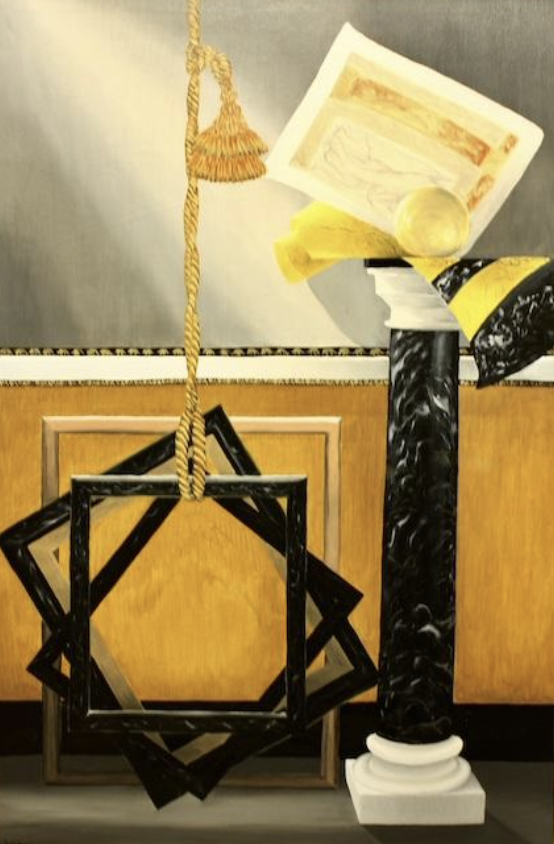
L’opera Colonna, con il suo ordine, con la sua geometrica simmetricità, non può non evocare le atmosfere criptiche e disorientanti della decontestualizzazione della Metafisica di Giorgio De Chirico; anche nella tela della Paone gli oggetti sembrano sospesi, legati a un’attesa di movimento che giungerà a rompere la staticità apparente, quell’essere in bilico su se stessi che in qualche modo riconduce alla destabilizzazione dell’uomo contemporaneo che cerca di appigliarsi a una falsa solidità il cui equilibrio può essere stravolto al primo crollo di uno solo degli elementi che compongono quelle certezze. Lo sguardo vaga dalle cornici vuote e sovrapposte, alla colonna, alla sfera e al foglio da essa trattenuto, come se volesse trovare un senso in quella composizione, come se avesse bisogno di comprendere il significato di quel disequilibrio per potergli attribuire un nuovo ordine, più possibilista, più aperto a modificazioni che abitualmente non sussistono.

In Zucca, l’ambiente circostante viene invece completamente oscurato per mettere in risalto una natura morta che proprio in virtù di quella rilevanza nello spazio diviene assoluta protagonista della tela, con la sua essenza, con quel suo essere semi avvolta da un telo che si tende verso il barattolo di vetro a lato, stimolando la riflessione su quanto un semplice oggetto possa assumere uno spessore assolutamente maggiore di quello che avrebbe nel momento in cui verrebbe confuso con il contesto circostante.

La capacità figurativa di Judith Paone si avvolge del significato profondo che la sua sensibilità riesce a infonder a ciascun elemento che cattura la sua attenzione fino a desiderare di renderlo protagonista di un’opera, lo evidenzia e poi lo colloca in uno spazio temporale sospeso, infondendo un’aura magica e suggestiva.
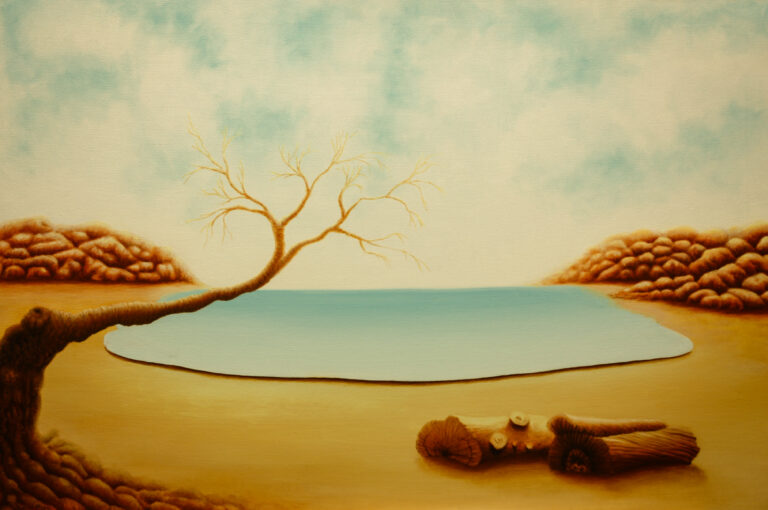
Questo talento innato della Paone si evidenzia nella tela Natura silente, in cui narra di un luogo non luogo più appartenente al mondo del sogno che non a quello reale, in cui il fascino del paesaggio si avvolge del magnetismo generato dall’insenatura in cui lo specchio d’acqua si arresta nell’incontro con la zona brulla che lo circonda, infondendo nell’osservatore la sensazione che sia la terra a costituire un ostacolo per l’avanzare della vitalità del mare. Si nasconde la metafora dell’umanità in quest’opera, umanità che spesso si inaridisce al punto di rifiutare tutto ciò che possa sopraggiungere a sovvertire un ordine a cui lentamente si abitua, ciò che potrebbe costituire nuova linfa se accolta come motivo e stimolo al cambiamento, all’accettazione di quella necessaria modificazione per trovare un inedito percorso in grado di restituire entusiasmo e vitalità. Ma, considerando un altro punto di vista, l’opera si avvicina anche al delicato tema dell’ecologia, mettendo in evidenza quanto la distrazione dell’uomo spesso danneggi la natura al punto di renderla un luogo brullo e desolato da cui solo un differente approccio, quello del saper fermare la corsa al progresso selvaggio, può riuscire a recuperare tutto ciò che durante molti anni è andato perduto.
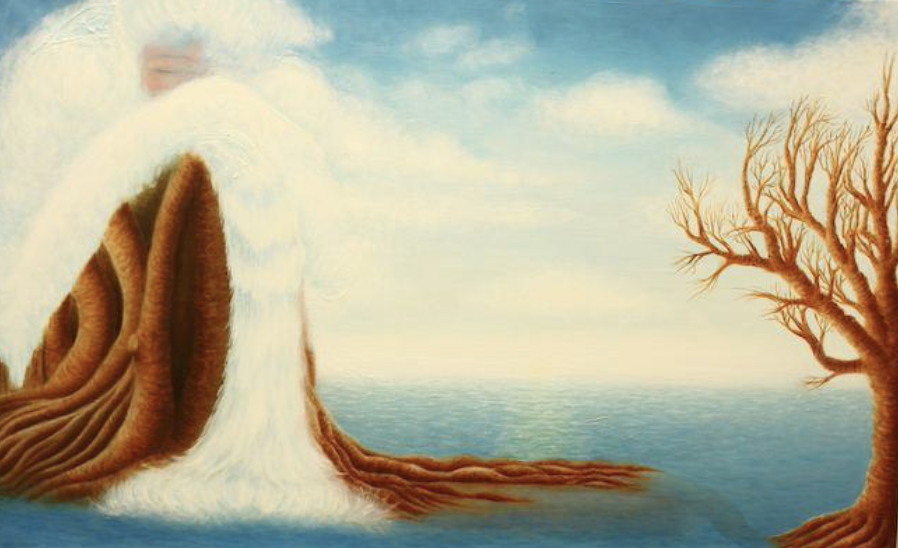
È proprio questo il senso del dipinto Lo spirito della terra nella quale l’anziano saggio rappresentato sotto forma di cascata sembra ripiegarsi su se stesso per comprendere i motivi del disprezzo apparente dell’uomo per l’ambiente in cui vive, e per generare quella vita, costituita dall’acqua, necessaria ad alimentare tutto ciò che è la base stessa dell’esistenza, malgrado spesso questo concetto di base venga dimenticato e accantonato di fronte a interessi maggiori; il grande saggio dalla chioma bianca appare in qualche modo sofferente, affranto, deluso, eppure non smette di alimentare la speranza che qualcosa possa cambiare, che vi sia presto un’inversione di tendenza in grado di permettere agli alberi di ricrescere rigogliosi e ai paesaggi di riconquistare tutta la loro floridezza.
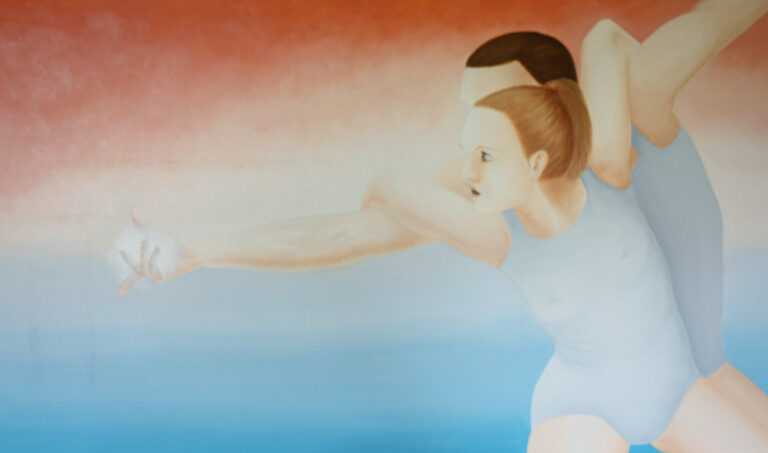
Judith Paone è un’artista eclettica che ama sperimentare differenti tecniche per l’esecuzione delle sue opere, dall’acrilico all’acquarello, dall’olio alla tempera, dai gessetti alla tecnica di marmorizzazione, dall’aerografo alla tecnica mista, tanto quanto differenti sono i supporti con cui si misura, dunque dalla tela passa alla scultura con vari materiali perché ciò che conta per lei è riuscire a esprimere le sue emozioni, a liberare la sua interiorità. Nel corso della sua carriera Judith Paone ha partecipato a numerose mostre collettive su tutto il territorio nazionale e a tre importanti mostre personali a Bolzano, nella sua città, mentre negli ultimi due anni ha cominciato a esporre anche all’estero, Helsinki e Rio De Janeiro, ricevendo apprezzamento dal pubblico e dalla critica.
JUDITH PAONE-CONTATTI
Email: paonejudith@gmail.com
Sito web: https://judithpaone.it/
Facebook: https://www.facebook.com/judith.paone
Instagram: https://www.instagram.com/paonejudith/
The deceptive universe of unreality in Judith Paone’s Metaphysical Surrealism
The exploration of the deepest meaning of things, the existential enigma constituted by everyday objects and places and the human need to put things in order whenever the gaze is deceived and led towards situations that are apparently similar to the known ones but in reality completely different and decontextualised, constituted the starting point for the expressiveness of a large group of artists of the last century, but also of today’s protagonist who makes the unreal her personal way of narrating emotions and sensations that can be traced back to herself but also to contemporary man.
When, at the beginning of the twentieth century, began to emerge the expressive tendency to go beyond the visible and explore not emotions, as had already happened in Expressionism, rather the subterranean world of the unconscious, of dreams but often of nightmares whose relevance in daily life was brought to light by the Austrian psychiatrist Sigmund Freud, some artists decided to create a current in which the representation of the psychic, restless and unreal sphere was at the centre of stylistic research. Surrealism, the name of the movement of which Salvador Dali was the founder and one of the main representatives, encompassed different ways of narrating the human unconscious, sometimes moving more towards the nightmares of a world in metamorphosis in which strange shapes partially envelop bodies and objects, as in the paintings of Max Ernst, other exponents focused on more instinctive and earthly impulses, such as the sexual or decidedly distressing parallel universes populated by disturbing animals and deformed objects of the famous works of Dali, or there were those who wanted to highlight the mystery of human thought, the meaning of existence and the enigma that sometimes hides behind a perfectly ordered appearance as in the fascinating and magnetic paintings of René Magritte.
And then the post-apocalyptic world of Yves Tanguy’s improbable and sinister scenarios, the raw interiority, the obsession with oneself and one’s own physical and inner pain of one of the women who represented the movement, Frida Khalo, right up to the childlike, stripped-down representation and bright colours of the outsider Joan Mirò. In the contemporary world, Surrealism continues to fascinate artists who are leaving a deep mark on the history of today’s art, updating the guidelines of the movement and adapting them to their own feelings as much as to their inner uncertainties or to a world thanks to which they can escape from everyday reality, as in the case of Vladimir Kush, a young and talented artist of Russian origin but naturalised in the United States, whose metamorphic and at the same time poetic canvases cannot fail to involve the observer. Judith Paone, from South Tyrol, is one of the emerging female artists who have chosen Surrealism as a means of expressing their delicate interiority. In her artworks, she allows to emerge emotions that are amplified by virtue of the evocative silence, focusing attention and the gaze not only on the main detail but on the entire surrounding atmosphere, from which the sensations seem to emanate until they reach the viewer of the canvas.
It is precisely because of this characteristic that Surrealism is combined with Metaphysics in her work, because of hera ability to skilfully mix the reflective enigma of the latter with the unreality and shifted meaning of the former, generating canvases with a strong emotional impact that drive towards meditation, feeling and the need to find meaning in what the eye is lost in. The artwork Colonna (Column), with its order, its geometric symmetry, cannot but evoke the cryptic and disorienting atmospheres of the decontextualisation of Giorgio De Chirico’s Metaphysical Art; in Paone’s painting too, the objects seem to be suspended, bound to an expectation of movement that will come to break the apparent static nature, that hovering over oneself which in some way leads back to the destabilisation of contemporary man who tries to cling to a false solidity whose equilibrium can be upset at the first collapse of just one of the elements that make up those certainties. The gaze wanders from the empty and superimposed frames to the column, the sphere and the sheet of paper held by it, as if it wanted to find a meaning in that composition, as if it needed to understand the meaning of that unbalance in order to be able to give it a new order, more possibilistic, more open to modifications that do not usually subsist. In Zucca (Pumpkin), the surrounding environment is instead completely obscured in order to highlight a still life which, precisely because of its relevance in space, becomes the absolute protagonist of the canvas, with its essence, with its being half-wrapped in a cloth that stretches towards the glass jar on the side, stimulating reflection on how a simple object can take on a greater importance than it would have when it is confused with its surroundings. Judith Paone’s figurative ability is wrapped up in the profound meaning that her sensitivity manages to infuse into each element that captures her attention to the point of wanting to make it the protagonist of an artwork, highlighting it and then placing it in a suspended space of time, infusing it with a magical and suggestive aura. Paone’s innate talent is evident in the canvas Natura silente (Silent Nature), in which she tells of a non-place that belongs more to the world of dreams than to the real world, in which the charm of the landscape is enveloped by the magnetism generated by the inlet in which the sheet of water comes to a halt when it meets the barren area surrounding it, instilling in the observer the feeling that it is the land that constitutes an obstacle to the advancing vitality of the sea.
The metaphor of humanity is hidden in this painting, a humanity that often dries up to the point of rejecting anything that might come along and subvert an order to which it is slowly becoming accustomed, something that might constitute what could constitute new lifeblood if welcomed as a reason and stimulus for change, for the acceptance of that necessary modification to find an unprecedented path capable of restoring enthusiasm and vitality. But from another point of view, the work also approaches the delicate issue of ecology, highlighting how human distraction often damages nature to the point of making it a barren and desolate place from which only a different approach, that of knowing how to stop the race for wild progress, can succeed in recovering all that has been lost over many years. This is precisely the meaning of the painting Lo spirito della Terra (The Spirit of the Earth) in which the elderly sage represented in the form of a waterfall seems to turn in on himself to understand the reasons for man’s apparent contempt for the environment in which he lives, and to generate that life, consisting of water, which is necessary to nourish everything that is the very basis of existence, despite the fact that this basic concept is often forgotten and set aside in the face of greater interests; the great wise man with the white foliage appears somewhat distressed, saddened, disappointed, yet he never ceases to nurture the hope that something will change, that there will soon be a reversal of the trend that will allow the trees to grow back and the landscapes to regain all their prosperity. Judith Paone is an eclectic artist who loves experimenting with different techniques for her artworks, from acrylic to watercolour, from oil to tempera, from chalks to marbling, from airbrush to mixed media, as different as the supports she uses to measure herself, so she moves from canvas to sculpture with various materials because what counts for her is being able to express her emotions, to free her interiority. Over the course of her career Judith Paone has taken part in numerous group exhibitions throughout Italy and in three major personal exhibitions in Bolzano, her home town, while in the last two years she has begun to exhibit abroad, in Helsinki and Rio De Janeiro, receiving appreciation from both the public and the critics.
